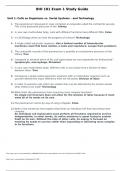Tentamen (uitwerkingen)
BIO 181 Exam 1 _General biology 1(with correct answers)
- Instelling
- Arizona State University
BIO 181 Exam 1 _General biology 1(with correct answers)BIO 181 Exam 1 _General biology 1(with correct answers)BIO 181 Exam 1 _General biology 1(with correct answers)BIO 181 Exam 1 _General biology 1(with correct answers)BIO 181 Exam 1 _General biology 1(with BIO 181 Exam 1 _General biology 1(with c...
[Meer zien]



